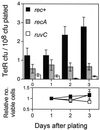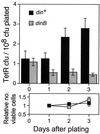Stationary-phase mutation in the bacterial chromosome: recombination protein and DNA polymerase IV dependence
- PMID: 11459972
- PMCID: PMC37440
- DOI: 10.1073/pnas.151009798
Stationary-phase mutation in the bacterial chromosome: recombination protein and DNA polymerase IV dependence
Abstract
Several microbial systems have been shown to yield advantageous mutations in slowly growing or nongrowing cultures. In one assay system, the stationary-phase mutation mechanism differs from growth-dependent mutation, demonstrating that the two are different processes. This system assays reversion of a lac frameshift allele on an F' plasmid in Escherichia coli. The stationary-phase mutation mechanism at lac requires recombination proteins of the RecBCD double-strand-break repair system and the inducible error-prone DNA polymerase IV, and the mutations are mostly -1 deletions in small mononucleotide repeats. This mutation mechanism is proposed to occur by DNA polymerase errors made during replication primed by recombinational double-strand-break repair. It has been suggested that this mechanism is confined to the F plasmid. However, the cells that acquire the adaptive mutations show hypermutation of unrelated chromosomal genes, suggesting that chromosomal sites also might experience recombination protein-dependent stationary-phase mutation. Here we test directly whether the stationary-phase mutations in the bacterial chromosome also occur via a recombination protein- and pol IV-dependent mechanism. We describe an assay for chromosomal mutation in cells carrying the F' lac. We show that the chromosomal mutation is recombination protein- and pol IV-dependent and also is associated with general hypermutation. The data indicate that, at least in these male cells, recombination protein-dependent stationary-phase mutation is a mechanism of general inducible genetic change capable of affecting genes in the bacterial chromosome.
Figures




References
-
- Lombardo M-J, Rosenberg S M. J Genet. 1999;78:13–21.
-
- Rosenberg, S. M. (2001) Nat. Rev. Genet., in press. - PubMed
-
- Lombardo M-J, Harris R S, Rosenberg S M. In: Plant Responses to Environmental Stresses: From Phytohormones to Genome Reorganization. Lerner H R, editor. New York: Dekker; 1999. pp. 71–90.
Publication types
MeSH terms
Substances
Grants and funding
LinkOut - more resources
Full Text Sources
Molecular Biology Databases

